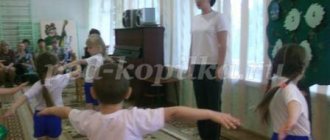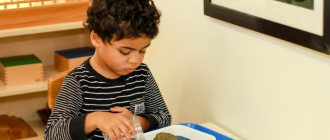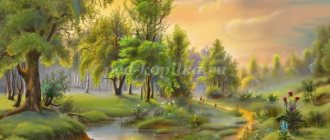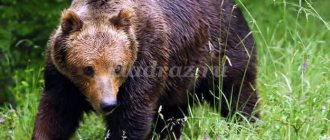Summary of a lesson on acquaintance with nature in the senior group
Lesson summary for children in the senior group of kindergarten
Topic: "Alone with nature."
Author: teacher of the first qualification category Matveeva Marina Sergeevna. ANODO “Childhood Planet “Lada” kindergarten “Belochka” No. 176. Purpose: Lesson for children of senior preschool age. Goal: 1. Formation of the ability to compose a descriptive story using pictures. 2. Clarify children’s ideas about the characteristic features of each season. 3. Formation of ideas about the regular repeatability of changes in the life of nature, from season to season. 4. Teach children to examine and examine objects of inanimate nature and draw conclusions. Course of the lesson: We sit on the floor in a circle. Handout cards for children. Educator: Guys, let's play the game “When does this happen?” It's time for riddles. Empty fields The ground gets wet It rains When it happens. Snow on the fields Ice on the rivers Blizzard walks When this happens. The snow is melting The meadow has come to life The day is coming When this happens The sun is baking The linden tree is blooming The rye is ripe When this happens Educator: Well done! Guys, guess the riddle: “White in winter, gray in summer.” Children: This is a hare. Educator: That's right, it's a bunny. And today he came to us to find out what we know about nature. There is a diagram on the table, and the children have cards with signs for the seasons. Let's start the story: Olya (on the card) - This is autumn. It rains in autumn. Puddles appeared. The sun shines less often in autumn. The weather is cloudy... The children tell one after another, one starts, the second continues, the third finishes. So about every season. Educator: The entire nature of the Earth can be divided into two huge worlds: the inanimate world, the world of living nature. We have pictures on the table: the boys need to select an image of non-living nature, and the girls need to select a picture of living nature and then explain how living nature differs from non-living nature (moves, grows, eats, breathes, reproduces). Let's check whether the pictures are chosen correctly: man, whale, dog, bird, elephant, tree, flower, hedgehog. They all eat, grow, breathe, so they are classified as living nature. And the sun, clouds, rainbows, stones, soil, water are classified as inanimate nature, since they do not have the ability to grow, feed, or breathe. Well done guys, you completed the task. Physical exercise: - Guys, please stand in a circle. The bunny will throw the ball to you, and you will return it with an answer. -after winter comes... -after summer... -winter month...(answers from several children) -summer month...(answers from several children) -after Tuesday... -day, and then... -night, and after it... -weekend... -migratory bird ... -wintering bird...(answers of several children) -who hibernates in the winter...(answers of several children) -who flies first in the spring... -which bird does not build its nest... -autumn month...(answers of several children) -spring month... (answers from several children) Educator: What natural phenomena do you know? (Wind, snow, rainbow, leaf fall, drops, ice drift, frost, dew, fog, icicles, drops, hail, rain, sun). And which ones are only available in winter? In summer? What types of clouds are there? (cumulus, cirrus, thunderstorm and rain) Which ones make it rain and snow? What is the name of the forest in which pine and spruce trees grow? What if there are trees? What if it's all together? (children's answers). At the end of the lesson, the bunny asks: “Guys, let’s remember what we talked about today, what new things we learned.” He praises the children and gives medals with his image.
We recommend watching:
Summary of an open lesson on the subject “Parquet gymnastics” for children 5-6 years old. Summary of a lesson on speech development in the senior group. Summary of GCD in the senior group “Musical Flower”. Summary of a lesson for children of senior preschool age. Kindness and politeness
Similar articles:
Lesson in the senior group. Topic: “Moods and Feelings”
Summary of a lesson on social and communicative development in the senior group according to the Federal State Educational Standard. Topic: "Relatives"
Summary of a lesson on labor education according to the Federal State Educational Standard in the senior group
Summary of a lesson in the senior group on the topic “History of Human Development”
Summary of a lesson on social and communicative development for children of the senior group. Compound
Lesson summary on the topic: “The world we live in” in the senior group
Target . Show the meaning of the integrity of the surrounding world, tell the image of nature. Pay attention to the variety of colors and shades. Improve technical skills in drawing with crayons. Teach to show imagination in drawing, to draw from an idea. Develop observation and a caring attitude towards the world around you. Cultivate interest in the world around you, neatness, and independence.
Materials . Colored chalks, illustration, sample.
Preliminary work. Reading books, looking at illustrations, drawing in free time.
Progress of the lesson
Educator. Guys, tell me where we live. (children's answer)
We live on earth correctly. (Read Svetlitskaya’s poem.)
We are a reflection of nature
We are part of it, we are Beauty.
We have strength, intelligence, kindness,
There is light and the Highest principle within us.
Unleash the Flower of Love within yourself,
Educator. Guys, look how beautiful the world around us is, our Planet. These include green forests, quiet sunsets, colorful bright flowers, quiet birch groves, distant cosmic distances. The planet is the house in which we live. And our planet is the only one where life exists.
Educator. Children, what is Earth? (children's answer). Our Planet alive? (children's answers).
Educator. Guys, listen to what poems the poet Tyutchev wrote.
Not what you think, nature,
Not a cast, not a soulless face, -
She has a soul, she has freedom,
It has love, it has language.
These are the beautiful lines the poet wrote.
Children, if our Earth could speak, what would it ask people to do? Maybe she's in pain? Or does she need help? What would you like to wish for our planet, our home? (Children's answers.)
Guys, I suggest you become artists and draw our beautiful Planet. Children, but remember, our Earth is also a great artist, its palette of colors is very diverse and bright. Remember the autumn colors, what is it like? Crimson, golden, with beautiful, bright leaves. What's the winter range? What about summer? (children's answers). Well done guys, but nature can teach a lot to those who are attentive and sensitive to it. Oh, guys, where are our paints and what kind of sticks are these? That's right, these are colored crayons and we will draw with them.
Guys, our fingers are not ready yet, let's play with them.
Finger gymnastics.
There is a Christmas tree in front of us.
Cones, needles.
Balls, lanterns.
Well done, we have prepared our fingers for drawing, and now let's start drawing.
During work, carry out individual work, help those children who are not succeeding, direct them towards positive emotions.
At the end of the lesson, review their drawings with the children, analyze and make a vernissage of children's drawings.
Getting to know the world around you
Familiarizing children with the world around them forms in children a holistic perception and understanding of various objects and phenomena of the surrounding reality.
Provides significant changes in the mental development of children. In the process of becoming acquainted with nature, children form an idea of the living and inanimate world, of the interrelationship of the interdependence of objects and natural phenomena.
In the section of the site, familiarization with the outside world in kindergarten for different groups, contains many interesting publications for educators on teaching children on various topics:
- Summary of an open lesson on familiarization with the environment and development of speech with children of the senior correctional group
- Outline of joint educational activities to familiarize yourself with the outside world
- Summary of organized educational activities familiarization with the surrounding world on the topic “Water”
- Lesson on the surrounding world in the middle group of kindergarten on the topic “Vitamins”
- Summary of an open integrated lesson on familiarization with the environment in kindergarten “Visiting the Mistress of the Copper Mountain”
- Summary of a lesson on familiarization with the outside world for children of the junior group of the kindergarten “Heroes of Folk Fairy Tales”
- Summary of a lesson on familiarization with the outside world in the senior group of kindergarten on the topic “Paper Collector”
- Organization of cooperation between children and adults in the process of interaction with people, culture and the outside world
- Technological map for familiarization with the outside world in kindergarten for children of the preparatory group on the theme “Earth Day”
- Summary of the final lesson on familiarization with the environment in a preparatory group for school on the topic “Space travel”
- Lesson on the world around us in kindergarten “The forest is full of secrets and wonders”
- Synopsis for a lesson on familiarization with the outside world at the preschool educational institution “Siege of Leningrad”
- Summary of a lesson on familiarization with the outside world in kindergarten on the topic “The child’s right to a first name, patronymic and last name”
- Summary of educational activities for familiarization with the outside world, middle group “Birds in winter”
- Lesson on the environment and ecology in kindergarten on the topic “Wild and domestic animals”
- Summary of a lesson on familiarization with the outside world, joint search and research activities
- Planning lessons on “The World Around You” at a preschool educational institution
- A comprehensive open lesson to familiarize children with the world around them “Fun Train”
- Summary of educational activities for familiarization with the outside world in the second junior group of the kindergarten “Walk in the Forest”
- Summary of the lesson on familiarization with the environment, second junior group
Familiarizing children with the world around them as a means of developing the horizons of older preschoolers. The main task of classes to familiarize themselves with the world around them is to form in children a holistic perception and understanding of various objects and phenomena of the surrounding reality.
Familiarizing preschoolers with the world around us is a means of developing in their minds realistic knowledge about the world, based on sensory experience and education of the correct world. The world around us is large and diverse. It includes the social world of people, the world of nature, and the world of objects created by man. Therefore, it is necessary to help the child build a holistic picture of the world, which synthesizes cognitive and aesthetic aspects, as well as moral norms of relations between people. The child’s idea of the objective and social world should be unified and holistic. It is important that the knowledge acquired by the child is not abstract, and that he understands and recognizes himself as part of the world around him.
Classes to familiarize yourself with the environment include familiarization with the phenomena of social life; familiarization with the objective world created by man; familiarization with the phenomena of living and inanimate nature. During classes, children are introduced to a certain type of properties, connections and relationships, specific to each of the four main areas of correctional pedagogical work highlighted in the program: Man, Object World, Living Nature, Inanimate Nature.
The subject Familiarization with the surrounding world has certain features not only in content, but also in teaching methods. The main characteristic feature of the subject “Acquaintance with the world around us” is that each topic is studied throughout the entire academic year. This is necessary in order to systematically develop children’s skills and behavior habits, to form in them the correct attitude towards the surrounding reality. Returning to the same topic throughout the year is also advisable in connection with seasonal changes in nature, as well as significant events in the life of our country.




